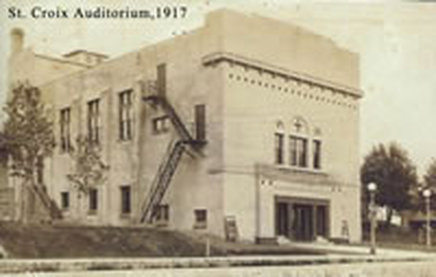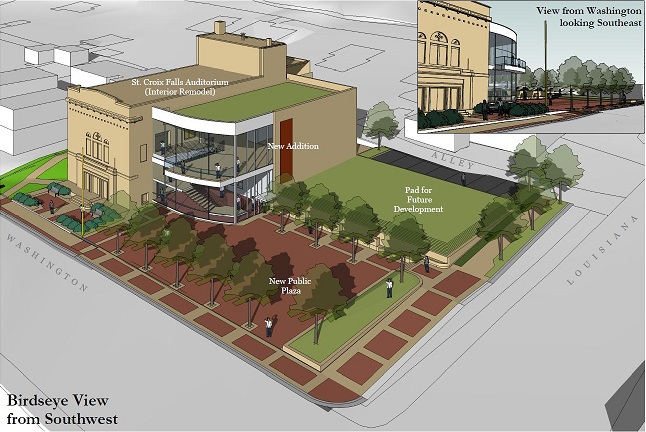History of the
|
Festival Theatre's HistoryIn June 1990 Peter Vaughan of the Minneapolis Star-Tribune wrote, “a better name for the fledgling St.Croix Festival Theatre might be the Serendipity Playhouse.” Once you know the story behind the theatre you may be inclined to agree.
Just four months prior to Vaughn writing his article, a young trio of theatre professionals had just discovered that their plans to launch a summer playhouse in Lake Geneva, Wisconsin had fallen through. A casual newspaper clipping about an historic theatre space being spruced up in a river town just 50 miles from the Twin Cities seemed a suitable substitute, and soon Carrie Classon-Smith as Artistic Director, Andrew Jensen as Business Manager, and Jason Smith as Technical Director arrived in St. Croix Falls to marshal support and enthusiasm for their dreams and successfully produced a rotating repertory that included The Show Off, Billy Bishop Goes to War, and School for Wives. The following year, 1990, St. Croix Festival Theatre was formally founded as a non-profit 501(c) (3) corporation to provide St. Croix Valley residents and visitors to this scenic region with highest quality of live professional theatre. In the years since, Festival Theatre has produced more than 100 plays for more than 200,000 St. Croix Valley residents and visitors. Were it not for Festival Theatre, many audience members would have an hour or more drive (each way) to the nearest professional theatre. Festival spent a few seasons producing theatre in Osceola’s ArtBarn, but returned to St. Croix Falls in 1996. As Classon-Smith, Jensen, and Smith moved into roles on the Board of Directors, James L. Walker and Marilyn Mays became Artistic Director and Business Manager in 1997, co-leading the theatre for two seasons. In 1999, Kate Riley and Pat Placzkowski were recruited from the Acting Company and led the theatre as co-Artistic Directors through the 2001 season. In 2002, Chris Reeder became the Artistic Director and served until 2005. Mark Baer joined Festival as Managing Director from 2003 to 2005. Danette Olsen served as Executive Director from February 2006 to January 2013. Pam Fuchs joined Festival's team as Business Manager in 2013. As Festival Theatre has grown over the past eighteen years, so has its commitment to the community. In 1998, Festival Theatre was named One of the Top Ten Theatres in America making a difference in their Community by Stage Directions magazine, a national trade journal. In March 2001, Festival Theatre was named Business of the Year by the St. Croix Falls Chamber of Commerce, in recognition of the theatre’s outreach programming and community involvement. Since 2001, the Student Matinee Series has served over 8,000 area students. Following severe back-to-back operating losses in 2004 and 2005, Festival’s Board of Directors reorganized with a transitional business plan and completed the 2006 season in the black and a record-setting holiday show, "Hans Brinker, or The Silver Skates." Danette Olsen was named Business Person of the Year by the St. Croix Falls Chamber of Commerce. Festival Theatre’s contribution to the community has also attracted and developed support from hundreds of local businesses in the form of in-kind donations, a growing subscriber base of nearly 1,000 individuals, and more than 100 dedicated volunteers who help out with various projects throughout the year. St. Croix Festival Theatre has truly become a community and cultural resource that makes a difference in the lives of people living in and visiting the St. Croix Valley. St. Croix Auditorium - 1917St. Croix Auditorium - 2017Get Involved in the Future of Festival TheatreFestival Theatre welcomes talented and dedicated volunteers to help shape the future of our home - the St. Croix Civic Auditorium - and professional theatre in the St. Croix River Valley.
Click here to find out how you can get involved. Historical Photo of the St. Croix River Valley |
St. Croix Festival Theatre
Franklin Square Black Box, 125 N. Washington St., PO Box 801, St. Croix Falls, WI, 54024
715.483.3387
[email protected]
Franklin Square Black Box, 125 N. Washington St., PO Box 801, St. Croix Falls, WI, 54024
715.483.3387
[email protected]



